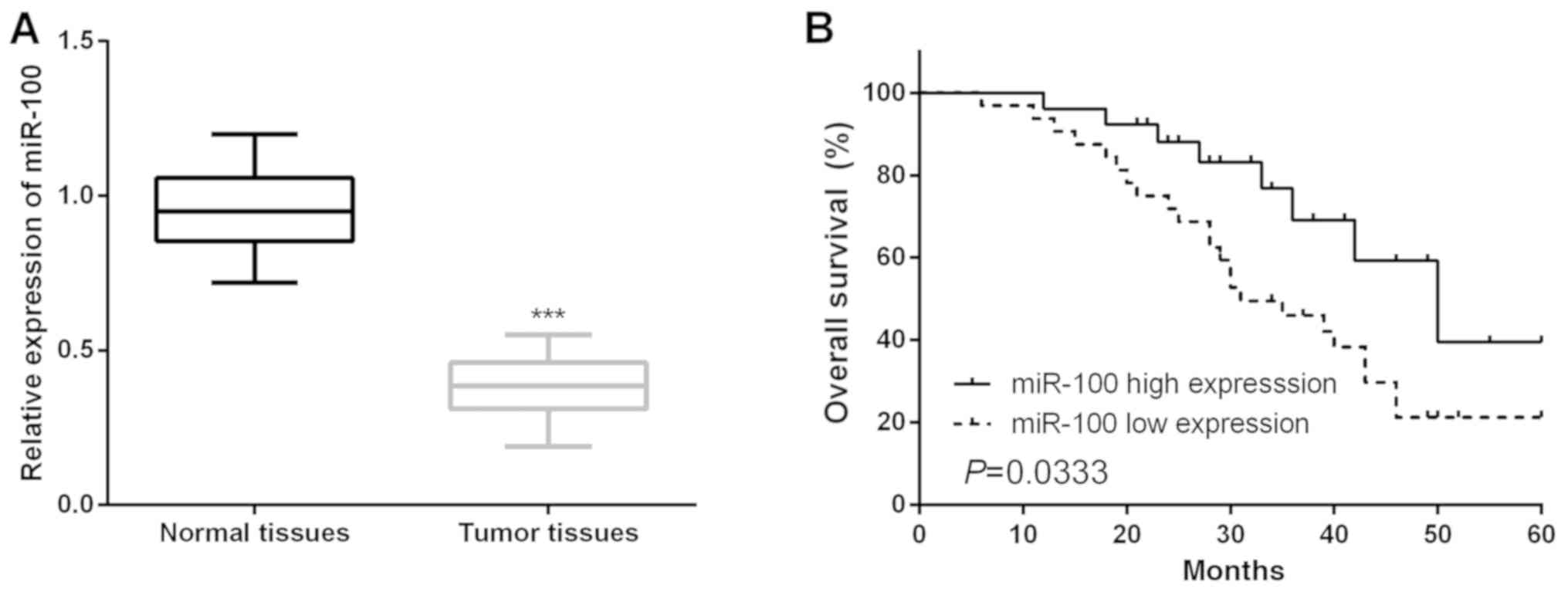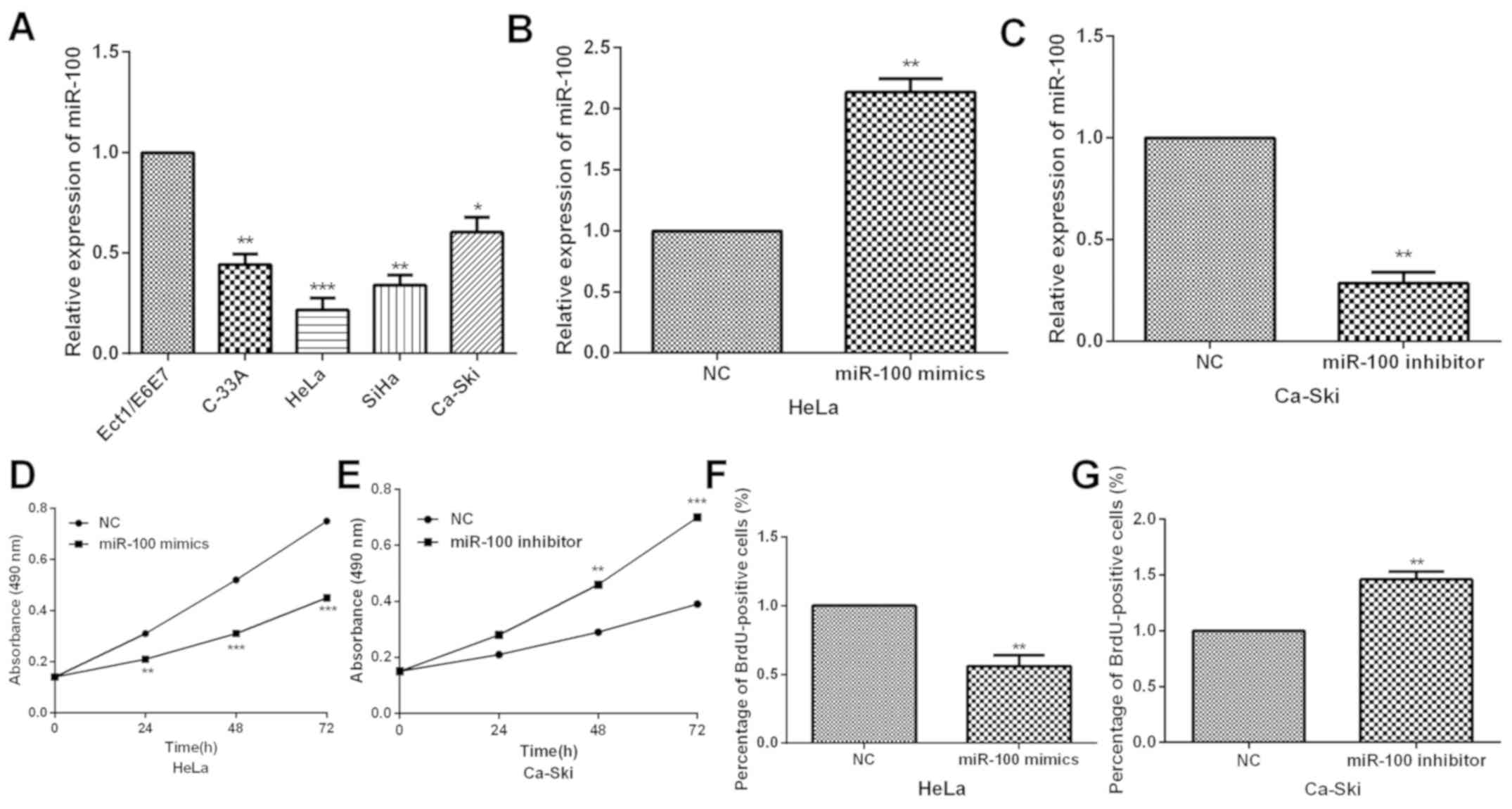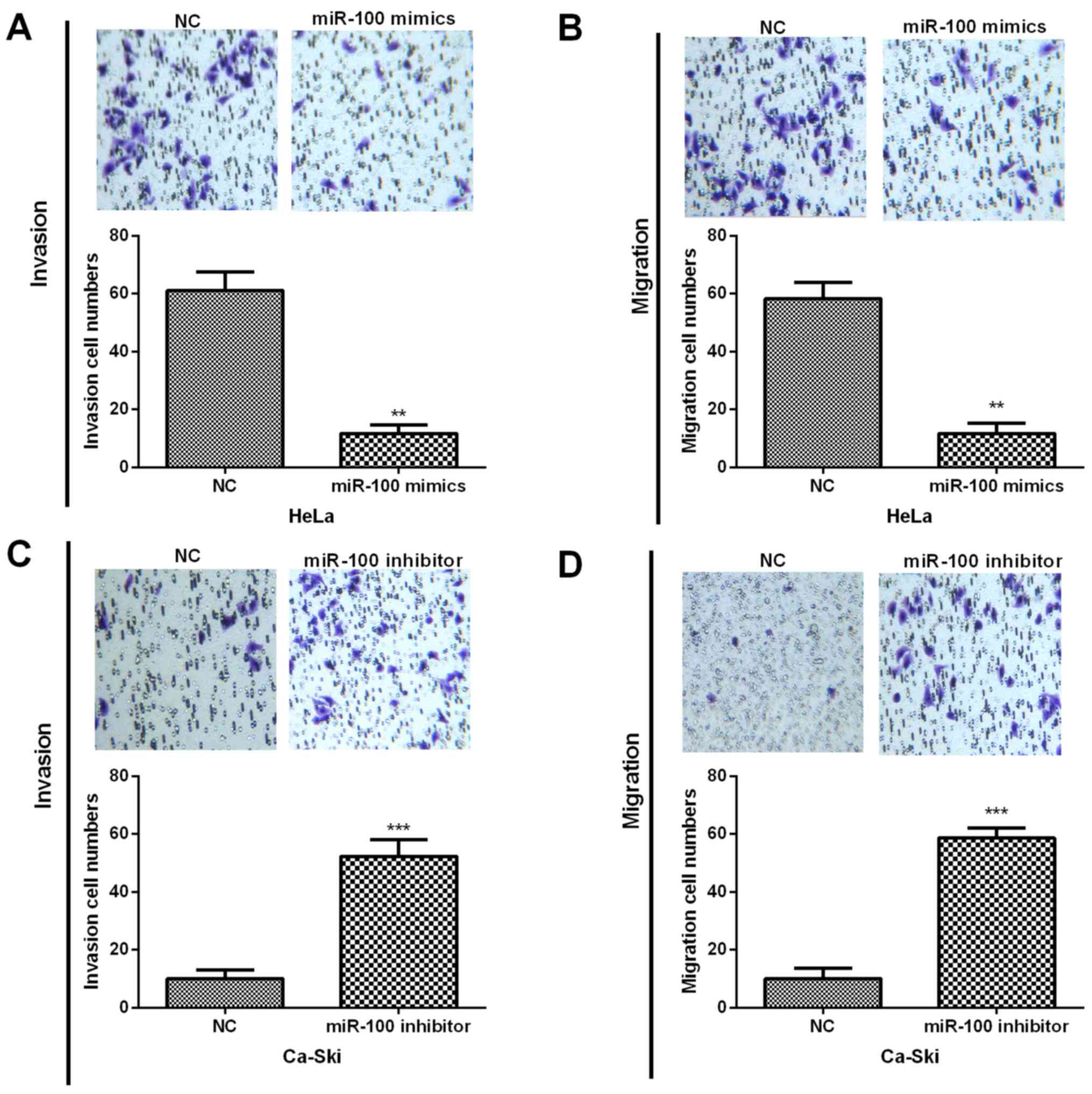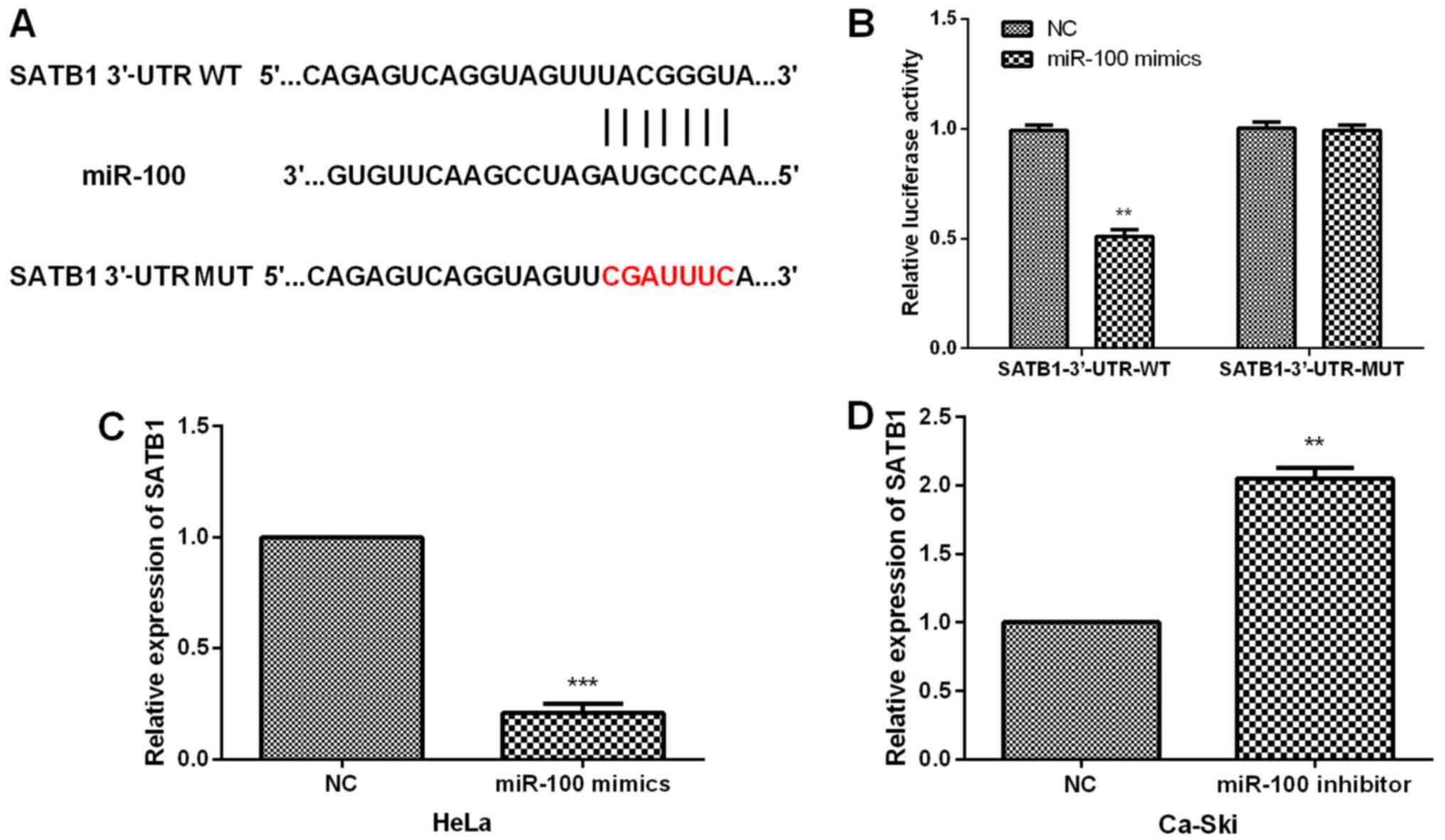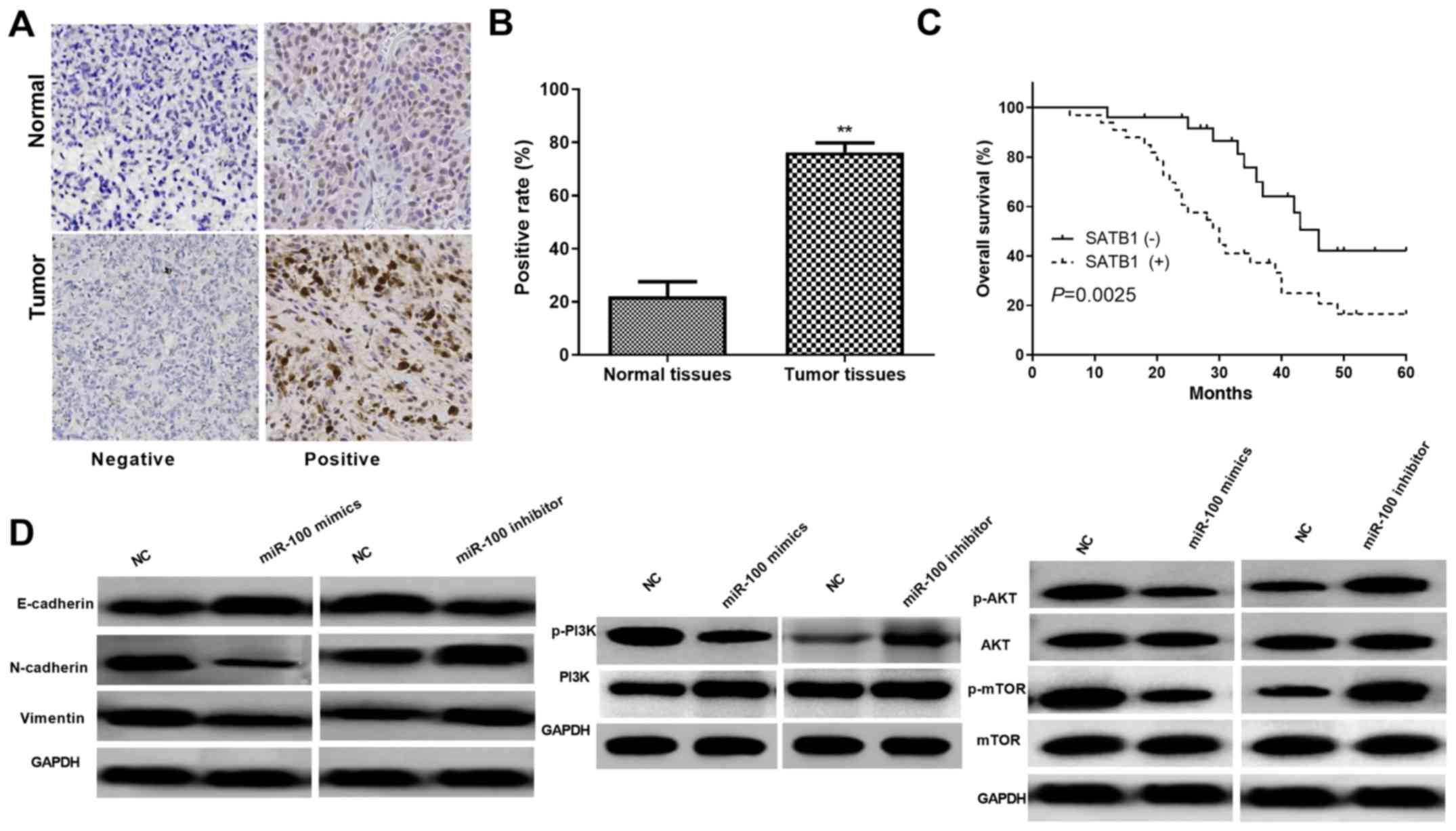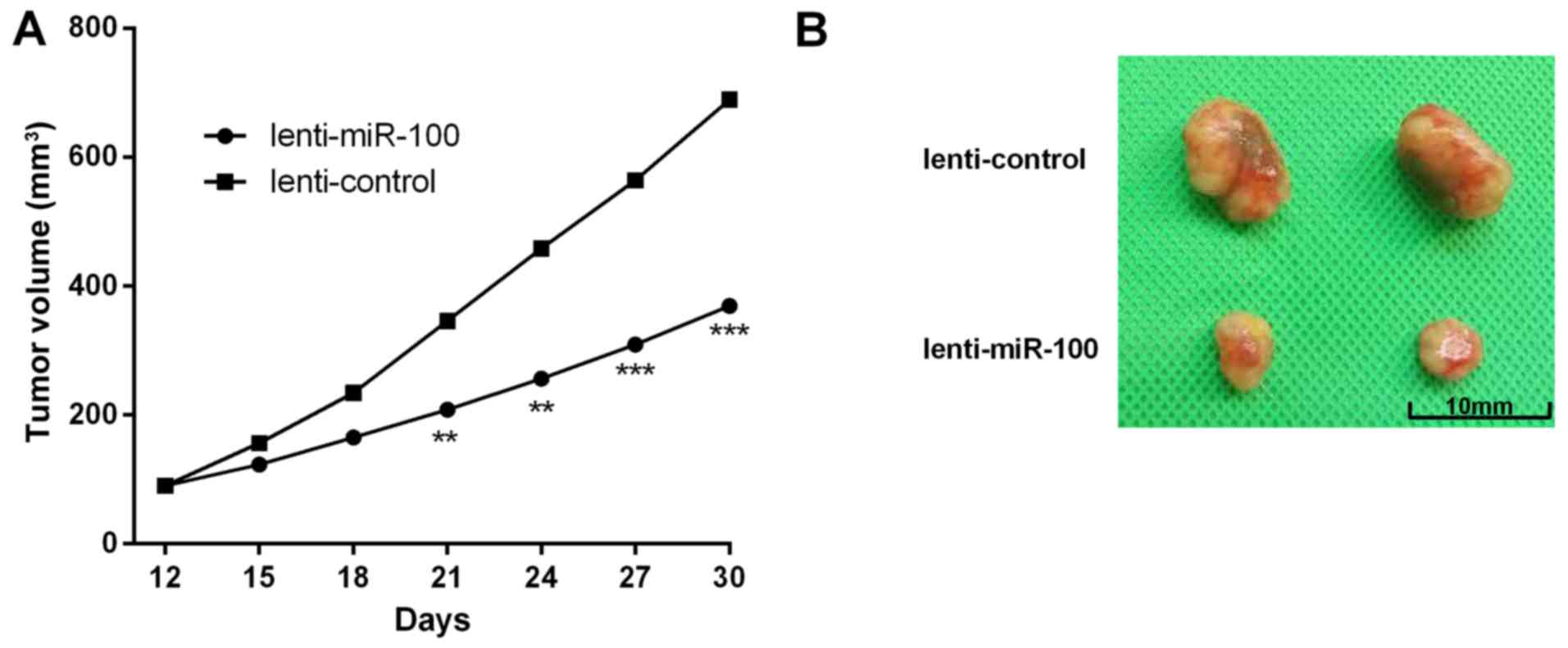|
1
|
Siegel RL, Miller KD and Jemal A: Cancer
statistics, 2016. CA Cancer J Clin. 66:7–30. 2016. View Article : Google Scholar : PubMed/NCBI
|
|
2
|
Carr KR, Ioffe YJ, Filippova M,
Duerksen-Hughes P and Chan PJ: Combined ultrasound-curcumin
treatment of human cervical cancer cells. Eur J Obstet Gynecol
Reprod Biol. 193:96–101. 2015. View Article : Google Scholar : PubMed/NCBI
|
|
3
|
Yu Q, Yang X, Duan W, Li C, Luo Y and Lu
S: miRNA-346 promotes proliferation, migration and invasion in
liver cancer. Oncol Lett. 14:3255–3260. 2017. View Article : Google Scholar : PubMed/NCBI
|
|
4
|
Puik JR, Meijer LL, Le Large TY, Prado MM,
Frampton AE, Kazemier G and Giovannetti E: miRNA profiling for
diagnosis, prognosis and stratification of cancer treatment in
cholangiocarcinoma. Pharmacogenomics. 18:1343–1358. 2017.
View Article : Google Scholar : PubMed/NCBI
|
|
5
|
Fang H, Xie J, Zhang M, Zhao Z, Wan Y and
Yao Y: miRNA-21 promotes proliferation and invasion of
triple-negative breast cancer cells through targeting PTEN. Am J
Transl Res. 9:953–961. 2017.PubMed/NCBI
|
|
6
|
Xiao R, Li C and Chai B: miRNA-144
suppresses proliferation and migration of colorectal cancer cells
through GSPT1. Biomed Pharmacother. 74:138–144. 2015. View Article : Google Scholar : PubMed/NCBI
|
|
7
|
Yang L, Liang H, Wang Y, Gao S, Yin K, Liu
Z, Zheng X, Lv Y, Wang L, Zhang CY, et al: MiRNA-203 suppresses
tumor cell proliferation, migration and invasion by targeting Slug
in gastric cancer. Protein Cell. 7:383–387. 2016. View Article : Google Scholar : PubMed/NCBI
|
|
8
|
Deng B, Zhang S, Zhang Y, Miao Y, Meng X
and Guo K: Knockdown of Tripartite Motif Containing 28 suppresses
the migration, invasion and epithelial-mesenchymal transition in
ovarian carcinoma cells through downregulation of Wnt/β-catenin
signaling pathway. Neoplasma. 64:893–900. 2017. View Article : Google Scholar : PubMed/NCBI
|
|
9
|
Wu HY and Cai XP: miR-338-3p suppresses
epithelial-mesenchymal transition and metastasis in human nonsmall
cell lung cancer. Indian J Cancer. 52 (Suppl 3):E168–E171. 2015.
View Article : Google Scholar : PubMed/NCBI
|
|
10
|
Chen H, Jia W and Li J: ECM1 promotes
migration and invasion of hepatocellular carcinoma by inducing
epithelial-mesenchymal transition. World J Surg Oncol. 14:1952016.
View Article : Google Scholar : PubMed/NCBI
|
|
11
|
Colditz J, Rupf B, Maiwald C and Baniahmad
A: Androgens induce a distinct response of epithelial-mesenchymal
transition factors in human prostate cancer cells. Mol Cell
Biochem. 421:139–147. 2016. View Article : Google Scholar : PubMed/NCBI
|
|
12
|
He H, Dai J, Xu Z, He W, Wang X, Zhu Y and
Wang H: Fbxw7 regulates renal cell carcinoma migration and invasion
via suppression of the epithelial-mesenchymal transition. Oncol
Lett. 15:3694–3702. 2018.PubMed/NCBI
|
|
13
|
Chen X, Liao Y, Yu Y, Zhu P, Li J, Qin L,
Liao W and Huang Z: Elevation of MAP17 enhances the malignant
behavior of cells via the Akt/mTOR pathway in hepatocellular
carcinoma. Oncotarget. 8:92589–92603. 2017. View Article : Google Scholar : PubMed/NCBI
|
|
14
|
Xue L, Wang Y, Yue S and Zhang J: Low
MiR-149 expression is associated with unfavorable prognosis and
enhanced Akt/mTOR signaling in glioma. Int J Clin Exp Pathol.
8:11178–11184. 2015.PubMed/NCBI
|
|
15
|
Cai S, Han HJ and Kohwi-Shigematsu T:
Tissue-specific nuclear architecture and gene expression regulated
by SATB1. Nat Genet. 34:42–51. 2003. View
Article : Google Scholar : PubMed/NCBI
|
|
16
|
Qi H, Fu X, Li Y, Pang X, Chen S, Zhu X,
Li F and Tan W: SATB1 promotes epithelial-mesenchymal transition
and metastasis in prostate cancer. Oncol Lett. 13:2577–2582. 2017.
View Article : Google Scholar : PubMed/NCBI
|
|
17
|
Li YC, Bu LL, Mao L, Ma SR, Liu JF, Yu GT,
Deng WW, Zhang WF and Sun ZJ: SATB1 promotes tumor metastasis and
invasiveness in oral squamous cell carcinoma. Oral Dis. 23:247–254.
2017. View Article : Google Scholar : PubMed/NCBI
|
|
18
|
Pan Z, Jing W, He K, Zhang L and Long X:
SATB1 is correlated with progression and metastasis of breast
cancers: A meta-analysis. Cell Physiol Biochem. 38:1975–1983. 2016.
View Article : Google Scholar : PubMed/NCBI
|
|
19
|
Hu XT, Chen W, Zhang FB, Shi QL, Hu JB,
Geng SM and He C: Depletion of the proteasome subunit PSMA7
inhibits colorectal cancer cell tumorigenicity and migration. Oncol
Rep. 22:1247–1252. 2009.PubMed/NCBI
|
|
20
|
Hu XT, Chen W, Wang D, Shi QL, Zhang FB,
Liao YQ, Jin M and He C: The proteasome subunit PSMA7 located on
the 20q13 amplicon is overexpressed and associated with liver
metastasis in colorectal cancer. Oncol Rep. 19:441–446.
2008.PubMed/NCBI
|
|
21
|
Kessler TA: Cervical cancer: Prevention
and early detection. Semin Oncol Nurs. 33:172–183. 2017. View Article : Google Scholar : PubMed/NCBI
|
|
22
|
Cordeiro MN, De Lima RC, Paolini F, Melo
AR, Campos AP, Venuti A and De Freitas AC: Current research into
novel therapeutic vaccines against cervical cancer. Expert Rev
Anticancer Ther. 18:365–376. 2018. View Article : Google Scholar : PubMed/NCBI
|
|
23
|
Zhang Y, Zhang D, Wang F, Xu D, Guo Y and
Cui W: Serum miRNAs panel (miR-16-2*, miR-195, miR-2861, miR-497)
as novel non-invasive biomarkers for detection of cervical cancer.
Sci Rep. 5:179422015. View Article : Google Scholar : PubMed/NCBI
|
|
24
|
Chen XF and Liu Y: MicroRNA-744 inhibited
cervical cancer growth and progression through apoptosis induction
by regulating Bcl-2. Biomed Pharmacother. 81:379–387. 2016.
View Article : Google Scholar : PubMed/NCBI
|
|
25
|
Chen AH, Qin YE, Tang WF, Tao J, Song HM
and Zuo M: MiR-34a and miR-206 act as novel prognostic and therapy
biomarkers in cervical cancer. Cancer Cell Int. 17:632017.
View Article : Google Scholar : PubMed/NCBI
|
|
26
|
Liu Y, Zhu ST, Wang X, Deng J, Li WH,
Zhang P and Liu BS: MiR-100 inhibits osteosarcoma cell
proliferation, migration, and invasion and enhances
chemosensitivity by targeting IGFIR. Technol Cancer Res Treat.
15:NP40–NP48. 2016. View Article : Google Scholar : PubMed/NCBI
|
|
27
|
Luan Y, Zhang S, Zuo L and Zhou L:
Overexpression of miR-100 inhibits cell proliferation, migration,
and chemosensitivity in human glioblastoma through FGFR3. Onco
Targets Ther. 8:3391–3400. 2015.PubMed/NCBI
|
|
28
|
Qureshi A, Fahim A, Kazi N, Farsi Kazi SA
and Nadeem F: Expression of miR-100 as a novel ancillary
non-invasive biomarker for early detection of bladder carcinoma. J
Pak Med Assoc. 68:759–763. 2018.PubMed/NCBI
|
|
29
|
Xiao T, Fu L and Jie Z: SATB1
overexpression correlates with gastrointestinal neoplasms invasion
and metastasis: A meta-analysis for Chinese population. Oncotarget.
8:48282–48290. 2017. View Article : Google Scholar : PubMed/NCBI
|
|
30
|
Huang B, Xiong F, Wang S, Lang X, Wang X
and Zhou H: Effect of SATB1 silencing on the proliferation,
invasion and apoptosis of TE-1 esophageal cancer cells. Oncol Lett.
13:2915–2920. 2017. View Article : Google Scholar : PubMed/NCBI
|















